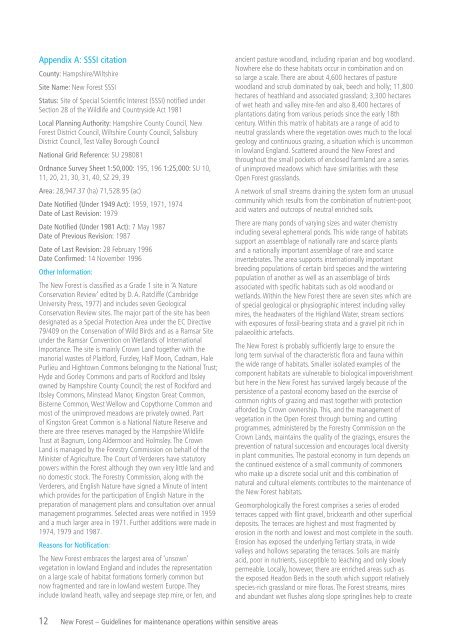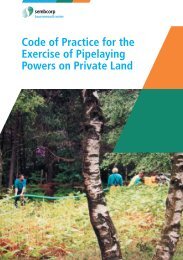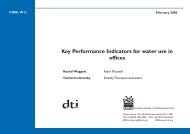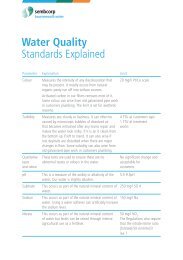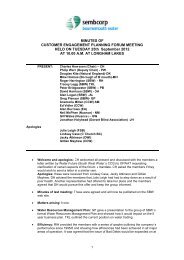New Forest - Sembcorp Bournemouth Water
New Forest - Sembcorp Bournemouth Water
New Forest - Sembcorp Bournemouth Water
- No tags were found...
Create successful ePaper yourself
Turn your PDF publications into a flip-book with our unique Google optimized e-Paper software.
Appendix A: SSSI citationCounty: Hampshire/WiltshireSite Name: <strong>New</strong> <strong>Forest</strong> SSSIStatus: Site of Special Scientific Interest (SSSI) notified underSection 28 of the Wildlife and Countryside Act 1981Local Planning Authority: Hampshire County Council, <strong>New</strong><strong>Forest</strong> District Council, Wiltshire County Council, SalisburyDistrict Council, Test Valley Borough CouncilNational Grid Reference: SU 298081Ordnance Survey Sheet 1:50,000: 195, 196 1:25,000: SU 10,11, 20, 21, 30, 31, 40, SZ 29, 39Area: 28,947.37 (ha) 71,528.95 (ac)Date Notified (Under 1949 Act): 1959, 1971, 1974Date of Last Revision: 1979Date Notified (Under 1981 Act): 7 May 1987Date of Previous Revision: 1987Date of Last Revision: 28 February 1996Date Confirmed: 14 November 1996Other Information:The <strong>New</strong> <strong>Forest</strong> is classified as a Grade 1 site in ‘A NatureConservation Review’ edited by D. A. Ratcliffe (CambridgeUniversity Press, 1977) and includes seven GeologicalConservation Review sites. The major part of the site has beendesignated as a Special Protection Area under the EC Directive79/409 on the Conservation of Wild Birds and as a Ramsar Siteunder the Ramsar Convention on Wetlands of InternationalImportance. The site is mainly Crown Land together with themanorial wastes of Plaitford, Furzley, Half Moon, Cadnam, HalePurlieu and Hightown Commons belonging to the National Trust;Hyde and Gorley Commons and parts of Rockford and Ibsleyowned by Hampshire County Council; the rest of Rockford andIbsley Commons, Minstead Manor, Kingston Great Common,Bisterne Common, West Wellow and Copythorne Common andmost of the unimproved meadows are privately owned. Partof Kingston Great Common is a National Nature Reserve andthere are three reserves managed by the Hampshire WildlifeTrust at Bagnum, Long Aldermoor and Holmsley. The CrownLand is managed by the <strong>Forest</strong>ry Commission on behalf of theMinister of Agriculture. The Court of Verderers have statutorypowers within the <strong>Forest</strong> although they own very little land andno domestic stock. The <strong>Forest</strong>ry Commission, along with theVerderers, and English Nature have signed a Minute of Intentwhich provides for the participation of English Nature in thepreparation of management plans and consultation over annualmanagement programmes. Selected areas were notified in 1959and a much larger area in 1971. Further additions were made in1974, 1979 and 1987.Reasons for Notification:The <strong>New</strong> <strong>Forest</strong> embraces the largest area of ‘unsown’vegetation in lowland England and includes the representationon a large scale of habitat formations formerly common butnow fragmented and rare in lowland western Europe. Theyinclude lowland heath, valley and seepage step mire, or fen, andancient pasture woodland, including riparian and bog woodland.Nowhere else do these habitats occur in combination and onso large a scale. There are about 4,600 hectares of pasturewoodland and scrub dominated by oak, beech and holly; 11,800hectares of heathland and associated grassland; 3,300 hectaresof wet heath and valley mire-fen and also 8,400 hectares ofplantations dating from various periods since the early 18thcentury. Within this matrix of habitats are a range of acid toneutral grasslands where the vegetation owes much to the localgeology and continuous grazing, a situation which is uncommonin lowland England. Scattered around the <strong>New</strong> <strong>Forest</strong> andthroughout the small pockets of enclosed farmland are a seriesof unimproved meadows which have similarities with theseOpen <strong>Forest</strong> grasslands.A network of small streams draining the system form an unusualcommunity which results from the combination of nutrient-poor,acid waters and outcrops of neutral enriched soils.There are many ponds of varying sizes and water chemistryincluding several ephemeral ponds. This wide range of habitatssupport an assemblage of nationally rare and scarce plantsand a nationally important assemblage of rare and scarceinvertebrates. The area supports internationally importantbreeding populations of certain bird species and the winteringpopulation of another as well as an assemblage of birdsassociated with specific habitats such as old woodland orwetlands. Within the <strong>New</strong> <strong>Forest</strong> there are seven sites which areof special geological or physiographic interest including valleymires, the headwaters of the Highland <strong>Water</strong>, stream sectionswith exposures of fossil-bearing strata and a gravel pit rich inpalaeolithic artefacts.The <strong>New</strong> <strong>Forest</strong> is probably sufficiently large to ensure thelong term survival of the characteristic flora and fauna withinthe wide range of habitats. Smaller isolated examples of thecomponent habitats are vulnerable to biological impoverishmentbut here in the <strong>New</strong> <strong>Forest</strong> has survived largely because of thepersistence of a pastoral economy based on the exercise ofcommon rights of grazing and mast together with protectionafforded by Crown ownership. This, and the management ofvegetation in the Open <strong>Forest</strong> through burning and cuttingprogrammes, administered by the <strong>Forest</strong>ry Commission on theCrown Lands, maintains the quality of the grazings, ensures theprevention of natural succession and encourages local diversityin plant communities. The pastoral economy in turn depends onthe continued existence of a small community of commonerswho make up a discrete social unit and this combination ofnatural and cultural elements contributes to the maintenance ofthe <strong>New</strong> <strong>Forest</strong> habitats.Geomorphologically the <strong>Forest</strong> comprises a series of erodedterraces capped with flint gravel, brickearth and other superficialdeposits. The terraces are highest and most fragmented byerosion in the north and lowest and most complete in the south.Erosion has exposed the underlying Tertiary strata, in widevalleys and hollows separating the terraces. Soils are mainlyacid, poor in nutrients, susceptible to leaching and only slowlypermeable. Locally, however, there are enriched areas such asthe exposed Headon Beds in the south which support relativelyspecies-rich grassland or mire floras. The <strong>Forest</strong> streams, miresand abundant wet flushes along slope springlines help to create12 <strong>New</strong> <strong>Forest</strong> – Guidelines for maintenance operations within sensitive areas


